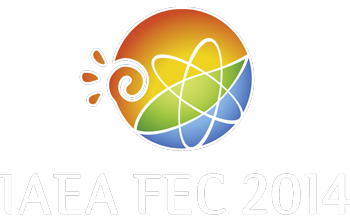Speaker
Dr
Robert Pinsker
(General Atomics)
Description
Modeling shows that fast waves at very high ion cyclotron harmonics (also called “whistlers” or “helicons”) can drive current efficiently in the mid-radius region of a high beta tokamak plasma, as is required to sustain steady-state high performance discharges in a DEMO-like configuration. DIII-D has developed discharges with high electron beta and high electron temperature so that full first-pass damping of the waves is expected to take place off-axis. We show that in a specific existing high-beta DIII-D target discharge, 0.5 GHz fast waves at launched n_|| ~ 3–4 would drive a noninductive current of 60 kA/MW at ρ=0.55, where the electron density is ~5x10^19 m^-3 and the electron temperature is ~3 keV. With complete first-pass absorption, loss processes (mode conversion, far-field sheath formation, etc.) associated with weak single-pass damping are minimized. The calculated current drive efficiency is 2 to 4 times higher than that of off-axis neutral beams or electron cyclotron current drive using the present DIII–D systems. Strong, radially localized absorption on electrons can be obtained only for local values of βe exceeding 1.8%. At lower values, the waves propagate to smaller minor radius before being absorbed. Varying the launched value of n_|| shows that the driven current hardly changes in either magnitude or in radial location in the range of 2.8<n_||<4.2, for reasons that are understood from examination of the ray data. We have identified an appropriate launching structure to excite a well-defined and toroidally directional wave spectrum — the traveling wave antenna known as the “comb-line”'. This structure permits the use of a large number of radiating elements in a phased array with feeds only at the ends of the wide, all-metallic antenna. The key parameter determining the necessary width of the array is the radial distance from the antenna surface to the location in the plasma edge where the rays begin to propagate. To determine this distance at the poloidal location of the proposed antenna, DIII-D will test a low-power prototype comb-line at that location to ascertain the needed width of the high-power antenna. We plan to perform the low power experiments in 2015 and proceed to experiments at the 1 MW level at 0.5 GHz in 2016.
This work was supported by the US Department of Energy under DE-FC02-04ER54698.
| Country or International Organisation | USA |
|---|---|
| Paper Number | TH/P2-38 |
Author
Dr
Robert Pinsker
(General Atomics)
Co-authors
Dr
Charles Moeller
(General Atomics)
Prof.
Miklos Porkolab
(MIT)
Dr
Orso Meneghini
(Oak Ridge Associated Universities)
Dr
Ron Prater
(General Atomics)
Prof.
Victor Vdovin
(Tokamak Physics Institute NRC Kurchatov Institute)

